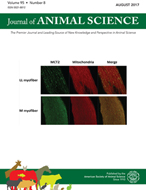-
Views
-
Cite
Cite
D. N. Miller, V. H. Varel, Swine manure composition affects the biochemical origins, composition, and accumulation of odorous compounds,, Journal of Animal Science, Volume 81, Issue 9, September 2003, Pages 2131–2138, https://doi.org/10.2527/2003.8192131x
Close - Share Icon Share
ABSTRACT
Odors from swine production facilities are associated with the storage and decomposition of manure. Diet is linked to manure composition and will likely affect odor, but the microbial mechanisms responsible for manure decomposition and odor production are poorly understood. To identify the sources of odor during manure fermentation, substrates (starch, casein, and cellulose) were added to slurries of fresh swine manure, and the anaerobic accumulation of fermentation products and the consumption of substrates were measured relative to no addition of substrates. Volatile fatty acids and alcohols were the dominant fermentation products in all treatments. The total VFA concentration from starch treatment was greater (P < 0.001) than for all other treatments. Branched-chain VFA and aromatic compounds accumulated in all treatments, but accumulation in the casein treatments was greater (P < 0.001) than in all other treatments. Thus, addition of carbohydrate to swine manure slurries did not circumvent protein fermentation, as was previously observed in cattle manure slurries. Based on substrate loss, starch and protein fermentation were equivalent in all treatments, with losses of each exceeding 4% of the DM. Substrate additions had a limited effect on the overall accumulation of odor compounds in manure and on odor compound composition. Compared with the results of the earlier fermentation study of fresh cattle manure, swine manure fermentation produced less lactate and more products of protein fermentation (branched-chain VFA and aromatic ring compounds). We hypothesize that differences in manure organic matter composition between cattle and swine, a result of diet and digestion, select for bacterial communities that are adapted to the available substrate composition.





